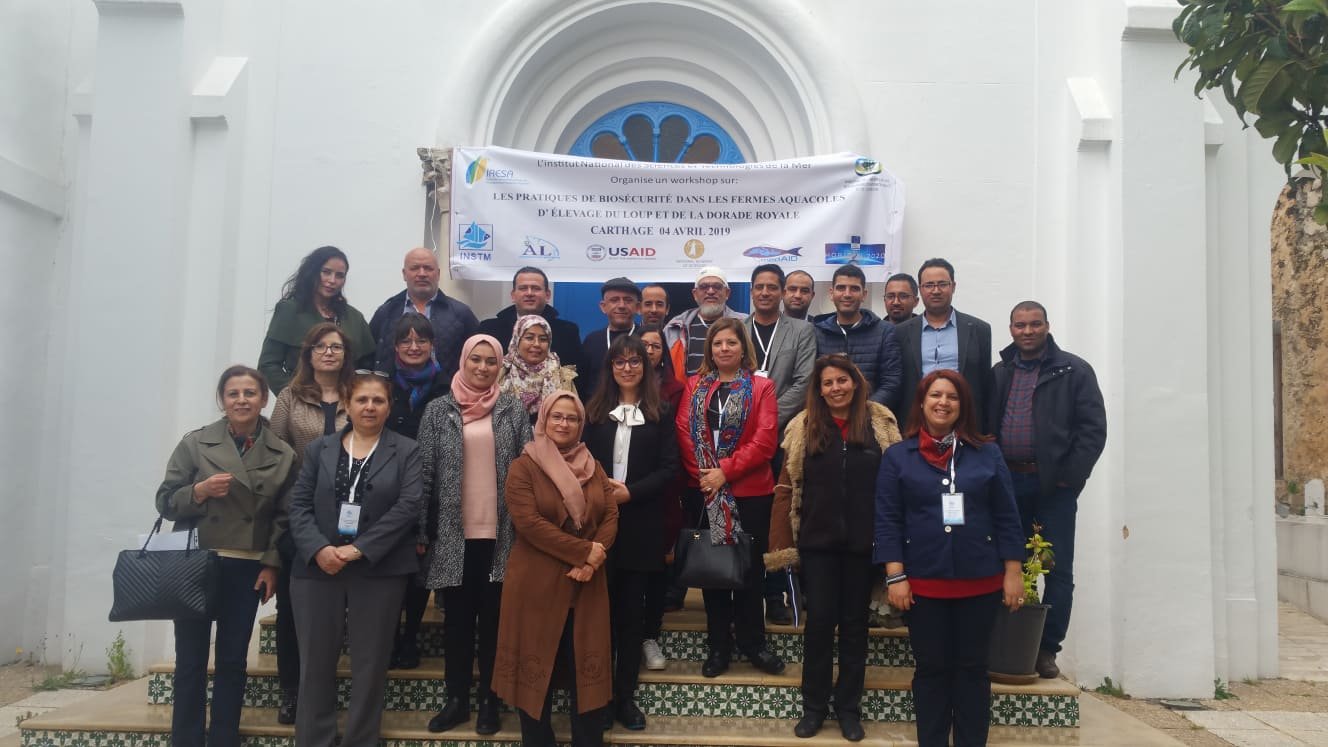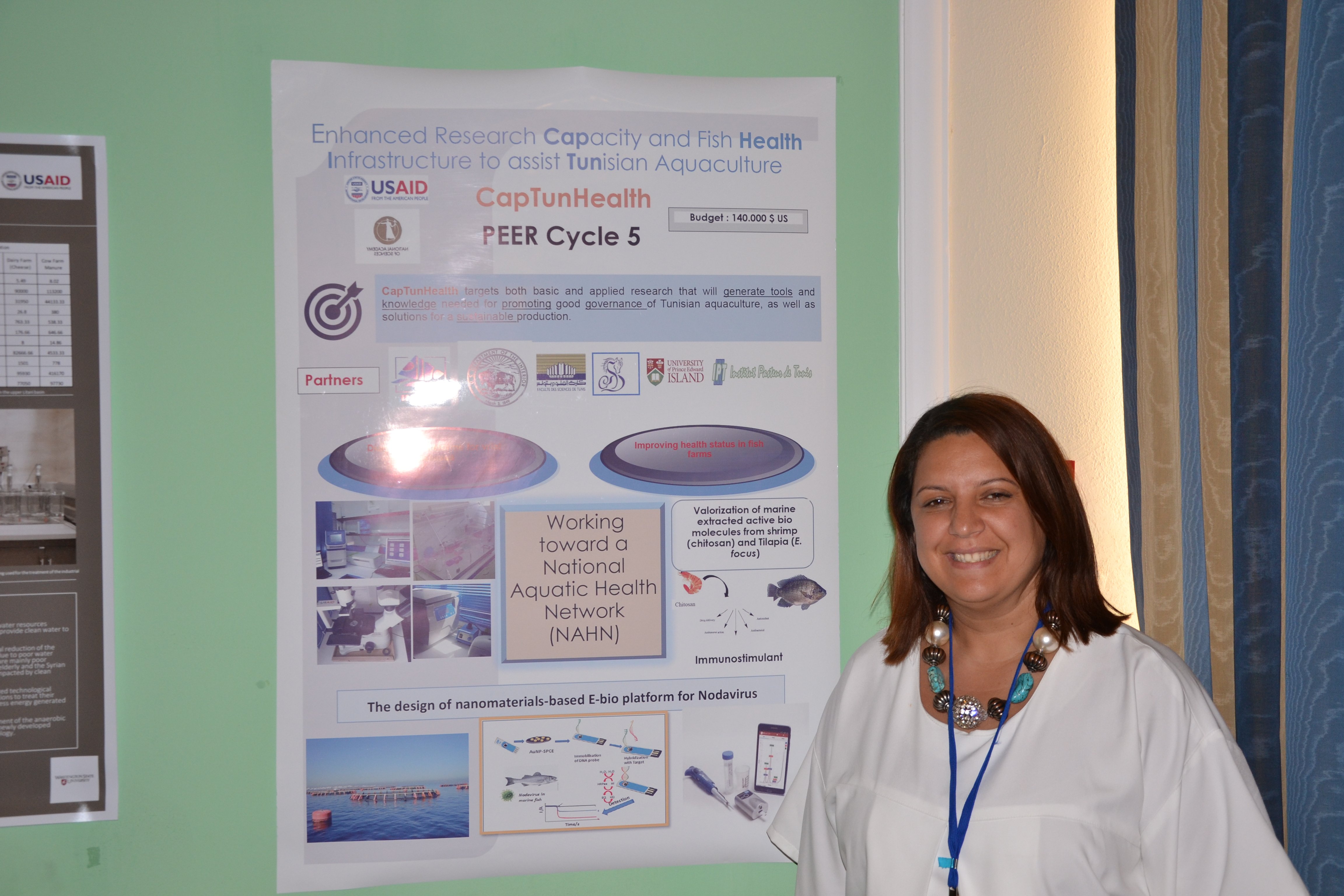|
Cycle 5 (2015 Deadline)
Enhanced research capacity and fish health infrastructure to assist Tunisian aquaculture
PI: Nadia Chérif (n.cherif@hotmail.com), Institut National des Sciences et Technologies de la Mer (INSTM)
U.S. Partner: James Winton, U.S. Geological Survey, Western Fisheries Research Center
Project Dates: December 2016-November 2019
Project Overview
Aquaculture is the fastest growing food-production sector in the world, providing a significant supplement to aquatic organisms harvested from the wild. However, the high density of animals reared in intensive aquaculture frequently produces infectious diseases that have emerged as major constraints to the successful development of aquaculture in many areas of the world. The project supported both basic and applied research that generated tools and knowledge needed for promoting social acceptance and good governance of Tunisian aquaculture, as well as solutions for sustainable production. The project had three objectives: (1) establishment of a Phase-1 prototype aquatic health network, an initiative towards development of a National Aquatic Health Network (NAHN) for Tunisia; (2) development of improved surveillance tools and characterize host defense mechanisms; and (3) application of nodavirus RNA3 as a biosensor. Key benefits from the research include providing an enabling environment for sustainable aquaculture, protecting investments from aquatic diseases and pests, and increasing research capacity for the prevention, early detection, and response to aquatic disease threats.
 | | The PEER project team. Picture courtesy of Dr. Cherif |
Final Summary of Project Activities
 | | The PI, Dr. Nadia Cherif. Picture courtesy of PI |
This project, which concluded in December 2019, aimed to advance research supporting the social acceptance and effective governance of Tunisian aquaculture, while also providing solutions for sustainable production. In the first phase, the project focused on bolstering fish health surveillance, resulting in the establishment of a comprehensive National Zoo-sanitary Program covering diseases affecting farmed fish species. The virology laboratory at the National Institute of Sea Sciences and Technologies (INSTM) was designated as the National Reference Laboratory, marking a significant milestone in the country's aquaculture management. A successful pilot program with a farm led to the expansion of the surveillance program to encompass all active fish farming units, with ongoing efforts to create a Policy Document outlining guidelines for the national zoo-sanitary surveillance network.
In the second phase, the project developed innovative biosensor chips for diagnosing infectious aquatic animal diseases. Overcoming initial challenges, the team achieved promising results, particularly in detecting fish nodaviruses. Utilizing two distinct approaches, the project focused on detecting viral genomes and developing specific nanobodies to enhance nodavirus detection and potentially inhibit its infection.
The third phase centered on evaluating bioactive molecules as probiotics to enhance fish immune systems or inhibit aquatic pathogens. Probiotics isolated from fish and chitosan extracted from shrimp were tested for their ability to inhibit nodavirus in vitro, demonstrating encouraging results. However, the in vivo evaluation was delayed due to infrastructure constraints. Nonetheless, chitosan emerged as a promising therapeutic agent against fish nodavirus.
Throughout the project, extensive engagement with technicians and farmers facilitated the dissemination of vital information on fish health and aquaculture procedures. Training workshops on biosecurity measures, viral disease diagnosis, and networking further enhanced knowledge sharing and capacity building within the aquaculture community.
In conclusion, the project achieved significant milestones in enhancing fish health surveillance, developing innovative diagnostic tools, and evaluating bioactive molecules for disease prevention in Tunisian aquaculture. These findings offer practical solutions for stakeholders, ultimately contributing to the sustainability and productivity of the aquaculture sector.
Publications
Nadia Chérif, Mohamed Zouari, Fatma Amdouni, Marwa Mefteh, Ayoub Ksouri, Balkiss Bouhaouala-Zahar, and Noureddine Raouafi. 2021. Direct Amperometric Sensing of Fish Nodavirus RNA Using Gold Nanoparticle/DNA-Based Bioconjugates. Pathogens 2021, 10, 932. https://doi.org/10.3390/pathogens10080932
Nadia Chérif, Fatma Amdouni, Boutheina Bessadok, Ghada Tagorti, and Saloua Sadok. 2021. Chitosan Treatment of E-11 Cells Modulates Transcription of Nonspecific Immune Genes and Reduces Nodavirus Capsid Protein Gene Expression. Animals 2021, 11, 3097. https://doi.org/10.3390/ani11113097
Nadia Chérif, Rym El Jeni, Fatma Amdouni, Sabrin Zreilli, Hanem Djabou, Sana Khemiri, Ines Tliba, Balkiss Bouhaouala-Zahar, Kaouther Maatoug, Sami Zaafran, and David Groman. 2021. Phylogeography of betanodavirus genotypes circulating in Tunisian aquaculture sites, 2012−2019. Diseases of Aquatic Organisms 146: 53-63. https://doi.org/10.3354/dao03614
Nadia Cherif, Amdouni Fatma. Nodaviruses in Wild Fish Population Collected Around Aquaculture Cage Sites from Coastal Areas of Tunisia. Fisheries and Aquaculture Journal 2017. hal-03632233
Back to PEER Cycle 5 Grant Recipients
|
|
|
|





